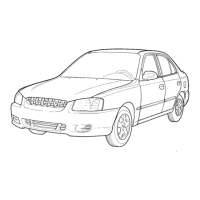EMISSION CONTROL SYSTEMSEMISSION CONTROL SYSTEMS
EMISSION CONTROL SYSTEMSEMISSION CONTROL SYSTEMS
EMISSION CONTROL SYSTEMS
7-1
7.7.
7.7.
7.
EMISSION CON-EMISSION CON-
EMISSION CON-EMISSION CON-
EMISSION CON-
TRTR
TRTR
TR
OL SYSTEMSOL SYSTEMS
OL SYSTEMSOL SYSTEMS
OL SYSTEMS
H010A01A-GAT
EMISSION CONTROL SYSTEMEMISSION CONTROL SYSTEM
EMISSION CONTROL SYSTEMEMISSION CONTROL SYSTEM
EMISSION CONTROL SYSTEM
(If Installed)(If Installed)
(If Installed)(If Installed)
(If Installed)
Your Hyundai is equipped with an emission
control system to meet all requirements of the
Emission prohibition rules of your province.
There are three emission control systems which
are as follows.
1) Crankcase emission control system
2) Evaporative emission control system
3) Exhaust emission control system
In order to assure the proper function of the
emission control systems, it is recommended
that you have your car inspected and main-
tained by an authorized Hyundai dealer in ac-
cordance with the maintenance schedule in this
manual.
the crankcase through the air intake hose.
Inside the crankcase, the fresh air mixes with
blow-by gases, which then pass through the
PCV valve and into the induction system.
H010C02A-GAT
2.2.
2.2.
2.
Evaporative Emission ControlEvaporative Emission Control
Evaporative Emission ControlEvaporative Emission Control
Evaporative Emission Control
System (If installed)System (If installed)
System (If installed)System (If installed)
System (If installed)
The Evaporative Emission Control System is
designed to prevent fuel vapors from escaping
into the atmosphere.
CanisterCanister
CanisterCanister
Canister
While the engine is inoperative, fuel vapors
generated inside the fuel tank are absorbed and
stored in the onboard canister. When the en-
gine is running, the fuel vapors absorbed in the
canister are drawn into the induction system
through
the purge control solenoid valve.
Purge Control Solenoid ValvePurge Control Solenoid Valve
Purge Control Solenoid ValvePurge Control Solenoid Valve
Purge Control Solenoid Valve
The purge control solenoid valve is controlled
by the ECM; when the engine coolant temper-
ature is low, and during idling, it closes, so that
evaporated fuel is not taken into the engine.
After engine warm-up, during ordinary driving, it
opens so as to introduce evaporated fuel to the
engine.
H010B01A-AAT
1.1.
1.1.
1.
Crankcase Emission Control Sys-Crankcase Emission Control Sys-
Crankcase Emission Control Sys-Crankcase Emission Control Sys-
Crankcase Emission Control Sys-
temtem
temtem
tem
The Positive Crankcase Ventilation System is
employed to prevent air pollution caused by
blow-by gases being emitted from the crank-
case. This system supplies fresh filtered air to
H010D01A-AAT
3. Exhaust Emission Control System3. Exhaust Emission Control System
3. Exhaust Emission Control System3. Exhaust Emission Control System
3. Exhaust Emission Control System
The exhaust emission control system is a high-
ly effective system which controls exhaust emis-
sion while maintaining good vehicle perfor-
mance.
H020A01A-GAT
CATALYTIC CONVERTER CATALYTIC CONVERTER
CATALYTIC CONVERTER CATALYTIC CONVERTER
CATALYTIC CONVERTER
(If Installed)(If Installed)
(If Installed)(If Installed)
(If Installed)
The catalytic converter is part of the exhaust
emission control system. It's purpose is to re-
move certain engine emission products from
the engine's exhaust. It looks something like a
muffler and is located underneath the car in the
exhaust system.
Catalytic Converter
H020A01A
77
77
7

